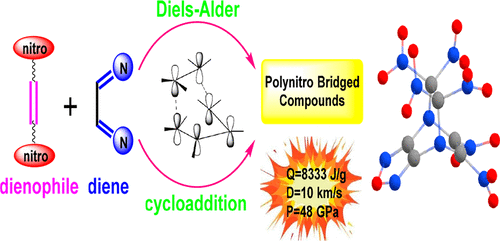当前位置:
X-MOL 学术
›
J. Phys. Chem. A
›
论文详情
Our official English website, www.x-mol.net, welcomes your feedback! (Note: you will need to create a separate account there.)
Design of New Bridge-Ring Energetic Compounds Obtained by Diels–Alder Reactions of Tetranitroethylene Dienophile
The Journal of Physical Chemistry A ( IF 2.9 ) Pub Date : 2018-03-08 00:00:00 , DOI: 10.1021/acs.jpca.8b01555 Piao He 1 , Hao-Zheng Mei 1 , Le Wu 1 , Jun-Qing Yang 1 , Jian-Guo Zhang 1 , Adva Cohen 2 , Michael Gozin 2
The Journal of Physical Chemistry A ( IF 2.9 ) Pub Date : 2018-03-08 00:00:00 , DOI: 10.1021/acs.jpca.8b01555 Piao He 1 , Hao-Zheng Mei 1 , Le Wu 1 , Jun-Qing Yang 1 , Jian-Guo Zhang 1 , Adva Cohen 2 , Michael Gozin 2
Affiliation

|
The density functional theory method was employed to calculate three-dimensional structures for a series of novel explosophores. The design of new molecules (DA1–DA12) was based on the bridge-ring structures that could be formed via Diels–Alder (DA) reaction of selected nitrogen-rich dienes and tetranitroethylene dienophile. The feasibility of the proposed DA reactions was predicted on the basis of the molecular orbital theory. The strong interactions between the HOMO of dienes, with electron-donating groups (Diene2, Diene6, and Diene8), and the LUMO of tetranitroethylene dienophile suggested thermodynamically favorable formation of the desired DA reaction products. In addition to molecular structures of the explored DA compounds, their physicochemical and energetic properties were also calculated in detail. Due to compact bridge-ring structures, new energetic molecules have highly positive heats of formation (up to 1124.90 kJ·mol–1) and high densities (up to 2.04 g·cm–3). Also, as a result of all-right ratios of nitrogen and oxygen, most of the new compounds possess high detonation velocities (8.28–10.02 km·s–1) and high detonation pressures (30.87–47.83 GPa). Energetic compounds DA1, DA4, and DA12 exhibit a superior detonation performance over widely used HMX explosive, and DA5, DA7, and DA10 could be comparable to the state-of-the-art CL-20 and ONC explosives. Our proposed designs and synthetic methodology should provide a platform for the development of novel energetic materials with superior performance.
中文翻译:

四硝基乙二烯亲二烯物的狄尔斯-阿尔德反应获得的新型桥环含能化合物的设计
密度泛函理论方法被用来计算一系列新型炸药团的三维结构。新分子(DA1 - DA12)的设计基于桥环结构,该结构可通过选定的富氮二烯与四硝基乙烯二烯亲和物的Diels-Alder(DA)反应形成。根据分子轨道理论预测了提出的DA反应的可行性。二烯的HOMO与给电子基团(Diene2,Diene6和Diene8),并且四硝基乙烯二烯亲和物的LUMO表明所需DA反应产物的热力学上有利的形成。除了探索的DA化合物的分子结构外,还详细计算了它们的物理化学和能量特性。由于紧凑的桥环结构,新的高能分子具有很高的正形成热(高达1124.90 kJ·mol –1)和高密度(高达2.04 g·cm –3)。同样,由于氮气和氧气的比例合理,大多数新化合物具有很高的爆炸速度(8.28-10.02 km·s –1)和很高的爆炸压力(30.87-47.83 GPa)。高能化合物DA1,DA4和DA12与广为使用的HMX炸药相比,它具有出色的爆炸性能,并且DA5,DA7和DA10可以与最新的CL-20和ONC炸药相媲美。我们提出的设计和合成方法应为开发性能卓越的新型含能材料提供一个平台。
更新日期:2018-03-08
中文翻译:

四硝基乙二烯亲二烯物的狄尔斯-阿尔德反应获得的新型桥环含能化合物的设计
密度泛函理论方法被用来计算一系列新型炸药团的三维结构。新分子(DA1 - DA12)的设计基于桥环结构,该结构可通过选定的富氮二烯与四硝基乙烯二烯亲和物的Diels-Alder(DA)反应形成。根据分子轨道理论预测了提出的DA反应的可行性。二烯的HOMO与给电子基团(Diene2,Diene6和Diene8),并且四硝基乙烯二烯亲和物的LUMO表明所需DA反应产物的热力学上有利的形成。除了探索的DA化合物的分子结构外,还详细计算了它们的物理化学和能量特性。由于紧凑的桥环结构,新的高能分子具有很高的正形成热(高达1124.90 kJ·mol –1)和高密度(高达2.04 g·cm –3)。同样,由于氮气和氧气的比例合理,大多数新化合物具有很高的爆炸速度(8.28-10.02 km·s –1)和很高的爆炸压力(30.87-47.83 GPa)。高能化合物DA1,DA4和DA12与广为使用的HMX炸药相比,它具有出色的爆炸性能,并且DA5,DA7和DA10可以与最新的CL-20和ONC炸药相媲美。我们提出的设计和合成方法应为开发性能卓越的新型含能材料提供一个平台。



























 京公网安备 11010802027423号
京公网安备 11010802027423号